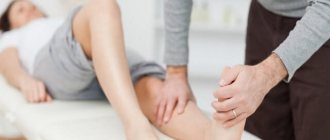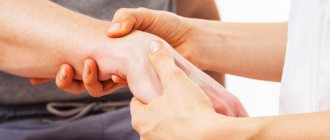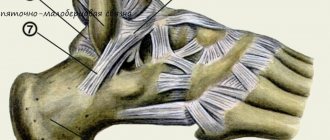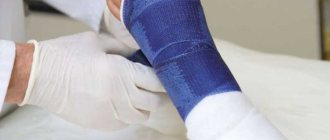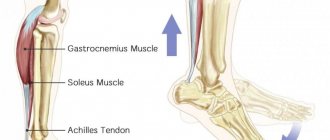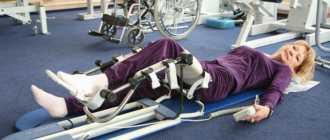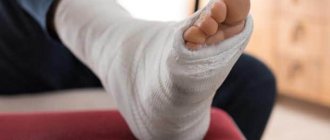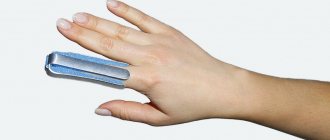A calcaneal injury affects the patient’s mobility and affects the health of not only the foot, but the entire leg. Reduced physical activity leads to muscle atrophy and negatively affects blood circulation and metabolism. Therefore, we recommend not limiting yourself to just applying a plaster cast, but be sure to consult a doctor who will draw up a program of rehabilitation measures.
Recovery after a heel fracture allows you to avoid a large number of complications, including hallux valgus, metatarsal bone deformity, degenerative changes in the joint, tendon irritation, periodic pain at the site of injury, the appearance of bone spurs, the development of flat feet, osteoporosis, arthritis, etc.
Features of recovery after a calcaneal fracture
The rehabilitation program can last up to six months, which depends on the severity of the injury, the individual characteristics of the patient (age, weight, physical activity, etc.) and the qualifications of the doctor.
The Blagopoluchiya specialist selects recovery methods individually: we do not use “template” solutions, since each case is unique, and only a personal approach allows us to solve the specific problems of each patient in the shortest possible time.
The rehabilitation program is comprehensive and consists of a number of techniques:
- Massage. It can be done even before the doctor removes the plaster cast: the massage therapist develops the areas around the plaster. The main goal of the method is to increase blood circulation. At first, the patient may experience discomfort. This is a normal reaction, but it is better to report it to a specialist.
- Physiotherapy. Particular attention is paid to the method if the fracture was displaced. The first simple exercises can be performed after the bone has healed: the patient bends and straightens the toes, rotates, flexes and straightens the foot, pulls the toe toward and away from him, walks on his toes and heels, rolls a ball with his foot, etc. Severe pain after a heel fracture there should not be: if the patient feels discomfort, then you should interrupt the training and report your condition to the doctor.
- Physiotherapy. They improve blood circulation, lymph circulation, relieve pain, inflammation, normalize metabolism, launch regeneration processes and promote faster restoration of bone and soft tissue. The doctor may prescribe electro- and phonophoresis, laser treatment, UHF, etc.
- Hydrotherapy. Usually the doctor prescribes warming baths, which restore muscle tone and normalize blood circulation.
- Proper nutrition. The diet should contain foods high in calcium, silicon and magnesium.
- Wearing orthoses and orthopedic shoes. Soft, rigid and semi-rigid orthoses reduce swelling and avoid muscle atrophy. And special insoles allow you to correctly distribute the load on the foot, making it less tired. They wear orthopedic shoes for at least six months, the doctor gives precise recommendations.
The patient is considered healthy if he can stand on the injured leg, walk and move without pain or any restrictions.
Application of massage
Massage is the first and best means of restoring muscle tissue. In most cases, it is indicated when a cast is placed on the free part of the leg. Even if movement is not recommended during immobilization, you can improve blood flow by gently massaging exposed areas.
After restriction of mobility, muscle atrophy, swelling due to fluid accumulation and metabolic disorders in tissues are observed. Massage helps stimulate the movement of blood and lymph, strengthen the walls of blood vessels, develop joints, helping with hands in moving the legs.
It is better to entrust the initial stage of massage to a specialist in order to understand how to perform the movements correctly. In the future, relatives will help, and it is also possible to do it yourself.
To enhance the effect, you can use massage cream or medications for external use.
What are the purposes of recovery procedures?
The specialist faces many tasks:
- Return muscles, ligaments and tendons to their former elasticity and normalize their tone.
- Restore motor functions of the leg, avoid muscle atrophy.
- Activate blood supply and lymph flow in the area not only of the heel, but also of the entire leg.
- Reduce tissue swelling, avoid inflammation and other complications after a fracture.
- Accelerate healing processes.
- Relieve pain syndrome.
Complex therapy, tailored individually for a particular patient, helps to accomplish these tasks. Doctors at Blagopoluchiya pay attention not only to the procedures themselves. They help patients place their feet correctly to avoid additional stress on the heel.
Recovery in specialized centers
Immediately after the operation, many begin to look for where to undergo rehabilitation under the supervision of specialists in order to regain all lost functions after a hip fracture. For such tasks, special centers are suitable, where they offer a complete program:
- Exercise therapy according to timing with the use of simulators;
- massage under the supervision of a doctor;
- kinesitherapy;
- selection of physiotherapy methods;
- working with a psychologist.
Additionally, you can take a voucher for sanatorium treatment. Such measures are carried out at a later date and are recommended for almost all patients.
Contraindications for fracture
Some patients believe that restorative procedures are necessary primarily while wearing a cast. But rehabilitation after a heel fracture after the cast is removed is no less important. During this period, you should also follow the doctor’s recommendations, do not overload the joint, and wear special orthopedic shoes selected by a specialist. Self-medication or ignoring therapy can lead to re-injury, pain, bone displacement, etc.
You can do exercise therapy after a fracture only with the permission of a doctor: even seemingly small loads can lead to serious consequences. The doctor selects the type of exercise, monitors the technique, the patient’s condition, determines the number of repetitions and range of movements.
When drawing up a rehabilitation program, the doctor carefully examines the patient to ensure that there are no contraindications to any of the recommended treatment methods. As a rule, a number of techniques are contraindicated for oncological, psychological, infectious, skin diseases, chronic diseases in the acute stage, etc.
Rehabilitation therapy methods
To restore the functionality of organs, you should resort to methods of physical rehabilitation. Their list includes:
- Physiotherapy – helps you recover using physical sources. Involves the use of special devices and devices. For example, electrical stimulation is used for disorders of motor activity, spinal injuries are restored using paraffin applications and thermal methods, laser therapy eliminates pain and swelling, magnetic therapy improves the general condition of the body.
- Massage is one of the most common rehabilitation methods, which helps stimulate blood circulation, activates muscles, and helps prepare for physical therapy. The duration of the course is about 10 sessions, each of which should preferably be carried out at least every other day.
- Reflexology is an effect on biological points on the patient’s body. The procedure mobilizes the body's internal resources, involving them in the healing process. There are several areas of this method: acupuncture - acupuncture;
- auriculotherapy - effects on the points of the ears;
- hirudotherapy - treatment for leeches;
- stone therapy - stone massage;
- vacuum therapy - cupping massage.
Calcaneal fracture: rehabilitation in
We pay close attention to each patient: our center has created all the conditions for a comfortable stay for sedentary patients. All our premises have anti-slip, threshold-free coating, wide doorways, there are ramps and handrails, we provide crutches, wheelchairs, and select orthoses and insoles.
Only modern equipment is used, and the center’s doctors regularly improve their skills in order to return patients to health and well-being in the shortest possible time.
Treatment of PTSD
PTSD or post-traumatic stress disorder is the result of a severe traumatic event. About 1 in 10 people are affected by this disorder.
There is a direct relationship between the severity of psychological trauma and the degree of threat to life. First of all, PTSD must be properly diagnosed. This usually occurs within six months from the moment of injury.
If more time has passed, a diagnosis can only be made if no alternative disorders have been identified. The treatment method for PTSD consists of the following steps:
- Prolonged exposure therapy is about helping people recognize and regulate thoughts and memories of trauma, and adjust their own beliefs. It is important to teach a person to perceive PTSD as stress, and not as weakness, as this helps to combat outbursts of anxiety, anger, and pay attention to the symptoms of the disease. Patients are taught to master relaxation techniques that will help manage their condition, both physically and emotionally.
- Drug therapy – can be used if necessary. This is done as part of an integrated approach, using drugs such as antidepressants and drugs that help eliminate the symptoms of the disorder. The timing and dosage are determined after diagnosis of the disease and depend on the degree and stage of PTSD.
Complete functional rehabilitation after injury
Even when the injury has healed and functions have been restored, one should not assume that the rehabilitation process is over and a full load can be placed on the damaged part of the body. If you make such a mistake, the following consequences may occur:
- re-injury;
- the occurrence of pain;
- development of diseases of the musculoskeletal system.
Therefore, in order to avoid such moments, you should remember the basic rule: full recovery takes a very long time, so you should train in a gentle manner, limiting the performance of strength exercises.
Depending on the nature of the injury, full recovery may take anywhere from several weeks to a year.
Getting injured, especially of a serious nature, is a great challenge for any person, since in the coming months they will have to go through difficult trials to restore their health. Rehabilitation helps with this. It must be completed so that recovery occurs as quickly as possible.
